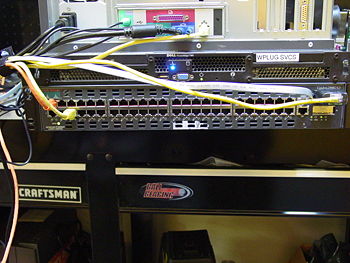Installfest Services
DEPRECIATED
NOTE: The content on this page is depreciated. The content will be updated on the weekend of 2/17/2012 to reflect current status.
Synopsis
Installfest "Services" is an working proof-of-concept by Brian A. Seklecki and Ted Rodgers to provide high performance servers for Linux Distro Boot, Install Media, and Updates retrieval via a local FTP/HTTP/RSYNC/NFS mirror within the Installfest event LAN.
The service runs on local hardware in the LAN. Having local install/update mirrors avoids the need for WPLUG attendees to consume commodity Internet (commercial upstream Internet Connectivity) at the InstallFest venue and thus saturating the limited WAN normally available.
NOTICE: WPLUG doesn't officially endorse or support the distros provided on Install Services; nor does provide any guarantees about the availability of service itself.
Network PXE Install Services (PXELINUX)
The current configuration of services provides a PXE environment. There PXE magic is a simple 'next-server' and 'boot-file' flags provided to the client via an extended attribute via DHCP offer reply (DHCP options 66/150).
The PXE code in the BIOS of your device will translate extra data into a TFTP client download the 1st/2nd stage boot loader from the server. Currently the system is configured to hand out Redhat/Fedora 'intermediate' boot loader clients from the Syslinux project.
The Syslinux code then executes a set of additional TFTP request and downloads its configuration files, modules, included config files, graphics, and other data.
The result is a menu of install'able operating systems; selecting an install target is analagous to booting from the install CD for that OS.
After the boot loader starts the OS install image, select DHCP auto network configuration (DHCP will renew from the BIOS to the OS).
Specific client MAC addresses can get specific bootloader code upon request.
At install time, when media selection occurs, select "URL" for media source and enter:
http://updates.wplug.org/pub/fedora/linux/releases/$releasever/Fedora/{i386,x86_64}/os
Update Services
After the OS update is complete, you can add new YUM update "repos" via inserting a file into /etc/yum.repos.d (for automatic inclusion).
Also, during the InstallFest, run all yum(8) commands with the default depos enabled:
Updates for Fedora Core 10 / i386
1) Install the following file into directory /etc/yum.repos.d/"
Fetch a Fedora Core 10 i386 YUM Repo Config File at http://digitalfreaks.org/~lavalamp/wplug-updates.repo
Sample:
[updates-wplug]
name=Fedora Core $releasever - $basearch - Updates from WPLUG InstallFest Services baseurl=http://updates.wplug.org/pub/fedora/linux/updates/$releasever/$basearch/ #mirrorlist=http://mirrors.fedoraproject.org/mirrorlist?repo=updates-released-fc$releasever&arch=$basearch enabled=1 gpgcheck=1 gpgkey=file:///etc/pki/rpm-gpg/RPM-GPG-KEY-fedora
Note: To ensure that the local WPLUG repositories are utilized instead of the default Redhat / Fedora for all yum(8) functions, always prepend the flag "--disablerepo=updates" to Yum commands until you are no longer connected to the installfest network
NOTE: "updates" here refers to the name of the default Fedora repo -- where as the new Repo is named "wplug-updates"
2) Update the available RPM database YUM maintains
# yum update
3) Update your system:
# yum check-update # yum upgrade
4) Test the repo is functional:
# yum install vim # yum update
NOTE: Ensure that the RPMs are downloaded locally and not remotely
Behind the Scenes
The system is run on a Redhat6 or Fedora16+ system (previously NetBSD)
The system is composed of:
- TFTP Service (defaults to an export of path /var/lib/tftp with read-only permissions)
- PXE Loader file system directory hierarchy
- PXE Loader menu config file
- Various bootloader code manually located in /var/lib/tftp (from various install CD/DVD images)
- Apache server and Media/Update directory hierarchy
More details soon.
Setup
After a base install, RHEL6 and F16 often lack a yum repo for the DVD media.
- server% sudo vim /etc/yum.repos.d/rhel-media.repo
[rhel6-media] name=RHEL-$releasever - Media baseurl=file:///media/cdrom/Server/ gpgcheck=1 enabled=1 gpgkey=file:///etc/pki/rpm-gpg/RPM-GPG-KEY-redhat-release
- Install the various packages:
server% sudo yum install xinetd tftp-server dhcp syslinux
- Enable TFTP Service
server% sudo vim /etc/xinetd.d/tftp && /sbin/service xinetd restart"
disable = no
- Copy the various syslinux files into place
server% sudo cp /usr/share/syslinux/{pxelinux.0,vesamenu.c32} /var/lib/tftpboot
server% mkdir /var/lib/tftpboot/pxelinux.cfg
- Populate the default config with a menu
server% sudo vim /var/lib/tftpboot/pxelinux.cfg/default
Try to match [Link to SVN repository here] Use this URL for now: https://alteeve.com/w/Setting_Up_a_PXE_Server_on_an_RPM-based_OS#The_Configuration_Files
NOTE: Setup a menu item for each distro. They vmlinuz and initrd will be relative to /var/lib/tftp and should reside in sub-directories.
- For each distro (rhel58,rhel62) copy the vmlinuz and initrd.img from the install (not the LiveCD) media
server% sudo mkdir -p /var/lib/tftpboot/rhel62 && cp /media/cdrom/isolinux/{initrd.img,vesamenu.c32} /var/lib/tftpboot/rhel62
- TFTP boot and load your end user device (permutations for i386/x86_64 will be required)
- Install Apache for the local media and updates service
NOTE: Make sure that ~500 gigs of space is available on /export
- Setup /etc/httpd/conf.d/wplug-services.conf
[Sample Soon]
- Setup a cron job to rsync a local copy of the redhat updates:
server% mkdir -p /export/services/linux/rhel/62 /export/services/linux/fedora/16
- Setup IPTables rules to permit inbound on 67,68,68, etc for DHCP/BOOTP and TFTP
% sudo iptables -L
ACCEPT tcp -- anywhere anywhere state NEW tcp dpt:ssh ACCEPT udp -- anywhere anywhere state NEW udp dpt:tftp ACCEPT udp -- anywhere anywhere state NEW udp dpts:bootps:bootpc
Install Services
The installfest service runs a DHCP+TFTP service which will serve PXE compatible boot loaders and kernels.
The service also provides NAT+PAT routing on an as-needed basis. When it is not functioning as a router, DHCP service should be turned off on the router in use.
